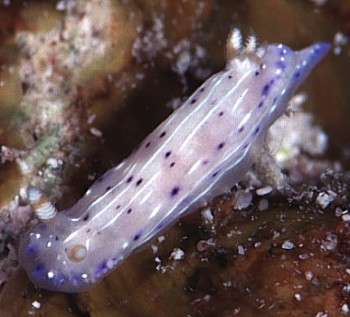
Hypselodoris cf. maculosa
Order: NUDIBRANCHIA
Suborder: DORIDINA
Superfamily: EUDORIDOIDEA
Family: Chromodorididae
See H. maculosa Page.
See Atsushi Ono's message below.
See Terry Gosliner's message below.
Rudman, W.B., 1999 (December 16) Hypselodoris cf. maculosa [In] Sea Slug Forum. Australian Museum, Sydney. Available from http://www.seaslugforum.net/find/hypscfma
Related messages
Hypselodoris cf. maculosa from Sri Lanka
October 5, 2007
From: Anouk Houben
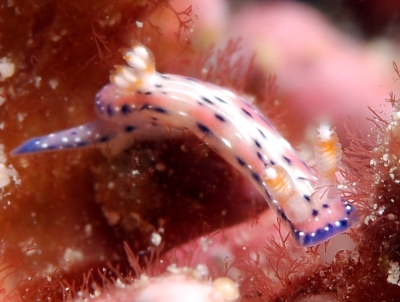
Hi Bill,
This tiny Hypselodoris was found on the Third reef off Negombo. Could it be Hypselodoris carnea? I didn't crop the picture since you might want to identify what this snail seems to be feeding on.
Locality: Third reef, Negombo, 16m, Sri Lanka, Indian Ocean, March 2007, patchy reef 20 km from the coast. Length: 1cm. Photographer: Anouk Houben.
Kind Regards,
Anouk
nashiman@lankacom.net
Houben, A., 2007 (Oct 5) Hypselodoris cf. maculosa from Sri Lanka. [Message in] Sea Slug Forum. Australian Museum, Sydney. Available from http://www.seaslugforum.net/find/20856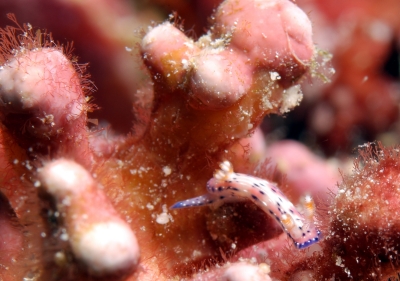
Dear Anouk,
Thanks for not cropping the photo, it certainly gave me a chance to look around for potential food or other details. Unfortunately there was nothing to see on this occasion. This is one of those species in which the gills and rhinophores have orange bands rather than being a single colour.
Your animal is what I am calling Hypselodoris cf maculosa. It looks a bit like H. maculosa but is different [see C. decora Colour Group] and doesn't appear to have a name at present.
Best wishes,
Bill Rudman
Hypselodoris maculosa? - another colour variation?
May 15, 2007
From: Colin Ogden
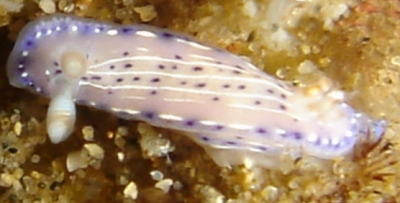
Hi Bill,
I found this nudi a couple of days ago, and it has got me stumped. It reminds me of both the Thorunna australis and also Hypselodoris maculosa.
Locality: Sodwana Bay, 15 metres, South Africa, Indian, Feb 2007, reef. Length: 15mm. Photographer: Colin Ogden.
Please could you help.
Thanks a ton
Colin
scubaco@iafrica.com
Ogden C. M., 2007 (May 15) Hypselodoris maculosa? - another colour variation?. [Message in] Sea Slug Forum. Australian Museum, Sydney. Available from http://www.seaslugforum.net/find/19616Dear Colin,
This is what I am calling Hypselodoris cf. maculosa. It has too many little differences for me to be comfortable with it being H. maculosa until we have a look at its anatomy
Best wishes,
Bill Rudman
Variations in Hypselodoris cf maculosa from Reunion Island
September 29, 2005
From: Philibert Bidgrain
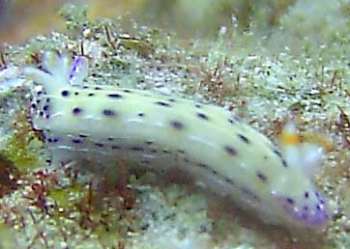
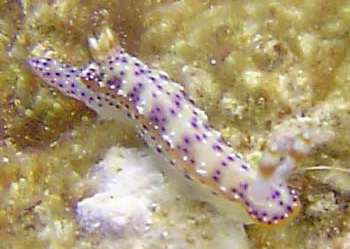
Dear Bill,
Reunion Island sea slugs.
To confirm Colin Ogden message [#14850] about the presence of this species in the east of Indian Ocean. I send these two specimens with a little variation in the coloration pattern. (one or two orange band on the rhinophore, importance of pinkish-purple spots on the mantle)
Locality: Saint Leu, Reunion island, Indian ocean. Depth: 10-15 m. Photographer: Emmanuel Eby
Are they really two specimens of Hypselodoris cf maculosa?
Best Regards
Philibert Bidgrain
http://vieoceane.free.fr/runseaslug/indexslug.htm
vieoceane@free.fr
Bidgrain, P., 2005 (Sep 29) Variations in Hypselodoris cf maculosa from Reunion Island. [Message in] Sea Slug Forum. Australian Museum, Sydney. Available from http://www.seaslugforum.net/find/14854Dear Philibert,
These animals certainly look like what I am 'pigeon-holing' as Hypselodoris cf maculosa. I am not sure if it is a distinct species, or a strange colour form of H. maculosa, which is quite variable in colour, or perhaps I have mixed up more than one species. I just feel it is better putting them together to alert us all to the possibility, rather than just identifying them as H. maculosa, where they will be forgotten.
Best wishes,
Bill Rudman
Hypselodoris from South Africa
September 28, 2005
From: Colin Ogden
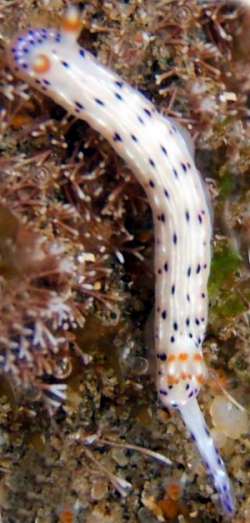
Note: this is part of another message [#14837] which I have duplicated because it contained two species
Hi Bill,
.... this photo was taken in a rock pool at low tide by Jesse, one of our local non divers who has developed a huge love for nudibranchs and other slugs and spends his free time looking in all the rock pools.
Locality: Sodwana Bay, South Africa, Indian Ocean coast. Length: approx 25 mm. August 2005. Coral reef. Photographer: Jesse
Colin Ogden
scubaco@iafrica.com
Ogden C. M., 2005 (Sep 28) Hypselodoris from South Africa. [Message in] Sea Slug Forum. Australian Museum, Sydney. Available from http://www.seaslugforum.net/find/14850Dear Colin,
This is an animal I am calling Hypselodoris cf. maculosa. It has similarities in colour and mantle gland arrangement to H. maculosa but in other ways looks very similar to two Hawaiian endemic species, H. peasei and H. bertschi. I can't say much more other than I think this is the first record of it from your side of the Indian Ocean. We really need to know something about its anatomy.
Best wishes,
Bill Rudman
Hypselodoris cf. maculosa from Sulawesi
March 24, 2000
From: Lindsay Warren
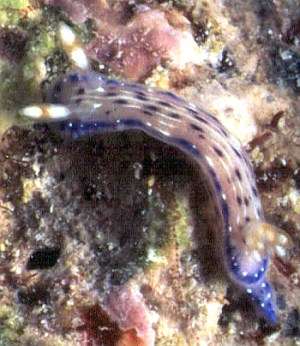
Dear Bill
This specimen was found by Dean Lea at 4pm on 7 July 1999 at a depth of 15m on filamentous algae on the lip of some dead foliose coral on Pulau Kaledupa [Tukang Besi Archipelago, SE Sulawesi, Indonesia - Operation
Wallacea]. Size: 5 mm.
The notum is pale cream with a bright blue marginal band to the mantle which is speckled with white. Along the notum running down its length are thin broken white lines interspersed with dark blue patches. The foot which is a pale bluey lilac features random blue spots along the foot. The rhinophores are lamellate, white with one horizontal orange band in the middle. The gills are translucent and white with a hint of orange.
Although it looked very similar to both Hypselodoris capensis and H. carnea,
the rhinophore bands did not match. What do you think it might be?
All the best
Lindsay Warren
100014.2112@compuserve.com
Warren, L., 2000 (Mar 24) Hypselodoris cf. maculosa from Sulawesi. [Message in] Sea Slug Forum. Australian Museum, Sydney. Available from http://www.seaslugforum.net/find/2143Dear Lindsay,
It is what we are calling Hypselodoris cf. maculosa for want of a better name. Terry Gosliner thinks it is a colour form of Hypselodoris maculosa and he may be right but I would like to see some anatomical evidence. See also the page showing the Chromodoris decora Colour Group.
Best wishes,
Bill Rudman.
Re: Hypselodoris cf. bertschi from Japan
December 20, 1999
From: Atsushi Ono
Dear Bill,
Thank you for your quick reply.
About Hypselodoris cf. bertschi,
I regret I have never seen one with an orange margin to the mantle. All I have seen are the same color pattern.
Sincerely,
Atsushi Ono
ononini@cosmos.ne.jp
Ono, A., 1999 (Dec 20) Re: Hypselodoris cf. bertschi from Japan. [Message in] Sea Slug Forum. Australian Museum, Sydney. Available from http://www.seaslugforum.net/find/1693Re: Hypselodoris bertschi
December 18, 1999
From: Terry Gosliner
Dear Bill,
I am very interested to see Atusushi's photos of the Hypselodoris from Japanese waters. I will admit that it looks somewhat like H. bertschi, but I think it is one of the many color variants of H. maculosa. The main reason I say this is based on the differences in distribution of mantle glands in the two species. In H. bertschi, the mantle glands form a continuous line from the posterior end of the animal to about the level of the rhinophores. In H. maculosa, the glands are interrupted in the middle region of the body. The animal in Atsushi's photo appears to lack glands in the middle region. Also, in both Mike Miller's photo to which you link and the photo in Bertsch and Johnson to which you refer have obvious and continuous mantle glands. In H. bertschi the dark spots tend to be larger than those of H. maculosa and the white lines are usually much fainter in H. bertschi. It would be nice to have a specimen to examine to confirm the anatomical differences. H. bertschi has a much larger penial sac and some radular differences, as well.
There is another problem with the name of H. bertschi that Kathe Jensen pointed out to me. Bergh (1880) stated in a footnote that Pease's Hawaiian specimens had the same name as Eydoux and Souleyet's Doris lineata and needed a new name. Bergh dseignated the name Chromodoris peasei for Pease's Hawaiian animals. Therefore the species should be called Hypselodoris peasei (Bergh, 1880) rather than H. bertschi. Sorry about that Hans!
This situation was made a bit more complex by the fact that Kay and Young included an animal they identified as H. peasei, but this animal is clearly a Noumea and most likely Noumea simplex.
All the best,
Terry
tgosline@calacademy.org
Gosliner, T., 1999 (Dec 18) Re: Hypselodoris bertschi. [Message in] Sea Slug Forum. Australian Museum, Sydney. Available from http://www.seaslugforum.net/find/1689Dear Terry,
As I said 'I may be wrong ..'. The mantle glands are clearly different, but the similarity in colour is quite amazing - especially after just discussing the similarities of Hypselodoris carnea and H. capensis.
I'll keep Atsushi's animal as Hypselodoris cf. maculosa so it doesn't get lost amongst the more 'typical' colour forms.
Thanks for clarifying the situation Terry, and its good to see the mantle glands being a very useful intrageneric character.
Cheers,
Bill Rudman.
Hypselodoris cf. bertschi from Kerama Is
December 17, 1999
From: Atsushi Ono

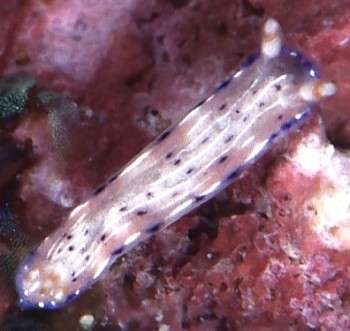
Dear Bill,
I found this small Hypselodoris species in Kerama Is. [near Okinawa].
This is very similar to H. carnea, but I have never seen one over 10mm long in my area.
I have seen over 10 individuals at a shallow coral reef and biggest was about 8mm. This is considered to be common species at Kerama Is. in autumn season.
In my pictures the upper is 7.5mm long, and the lower is 5.5mm long.
At first I thought this is a H. maculosa variation or juvenile. But I do not think so now. Could you help me to identify it?
Sincerely,
Atsushi Ono
ononini@cosmos.ne.jp
Ono, A., 1999 (Dec 17) Hypselodoris cf. bertschi from Kerama Is. [Message in] Sea Slug Forum. Australian Museum, Sydney. Available from http://www.seaslugforum.net/find/1686Dear Atsushi,
I think this is a particularly interesting find. I may be wrong but I think this is a species which Terry Gosliner & Rebecca Johnson have recently described as Hypselodoris bertschi, a species only known from the Hawaiian Islands.
The only colour differences I can find in their description is that they say there is an orange band around the mantle margin and the white gills have an orange rachis. However Kay & Young's description (1967) of the Hawaiian species [as Hypselodoris lineata (Pease)] states that the 'margin is sometimes edged with white, sometimes with a narrow band of blue, and at other times margined with orange-yellow' and that the gills are 'transparent white with splashes of orange at the tips.'
A photo in Bertsch & Johnson's Hawaiian Nudibranchs (1981; p.65) is almost identical to your animals. If they are the same this is the first record outside of Hawaii. Hawaiian animals grow to about 35mm long. Mike Miller has recently posted a picture from Hawaii on his Slug Site Nudi of the week 171.
Have you seen any colour variation in Kerama Island animals? It would be interesting to know if they ever have an orange margin to the mantle.
Best wishes,
Bill Rudman.
Reference:
Gosliner, T.M. & Johnson, R.F. (1999) Phylogeny of Hypselodoris (Nudibranchia: Chromodorididae) with a review of the monophyletic clade of Indo-Pacific species, including descriptions of twelve new species. Zoological Journal of the Linnean Society, 125: 1-114.
Kay, E.A. & Young, D.K. (1969) The Doridacea (Opisthobranchia: Mollusca) of the Hawaiian Islands. Pacific Science, 23(2): 172-231.
Rudman, W.B., 1999 (Dec 17). Comment on Hypselodoris cf. bertschi from Kerama Is by Atsushi Ono. [Message in] Sea Slug Forum. Australian Museum, Sydney. Available from http://www.seaslugforum.net/find/1686